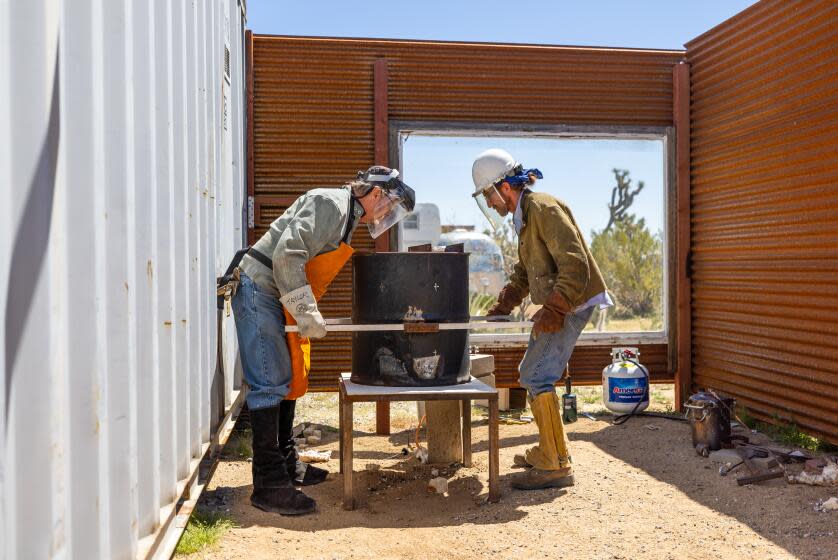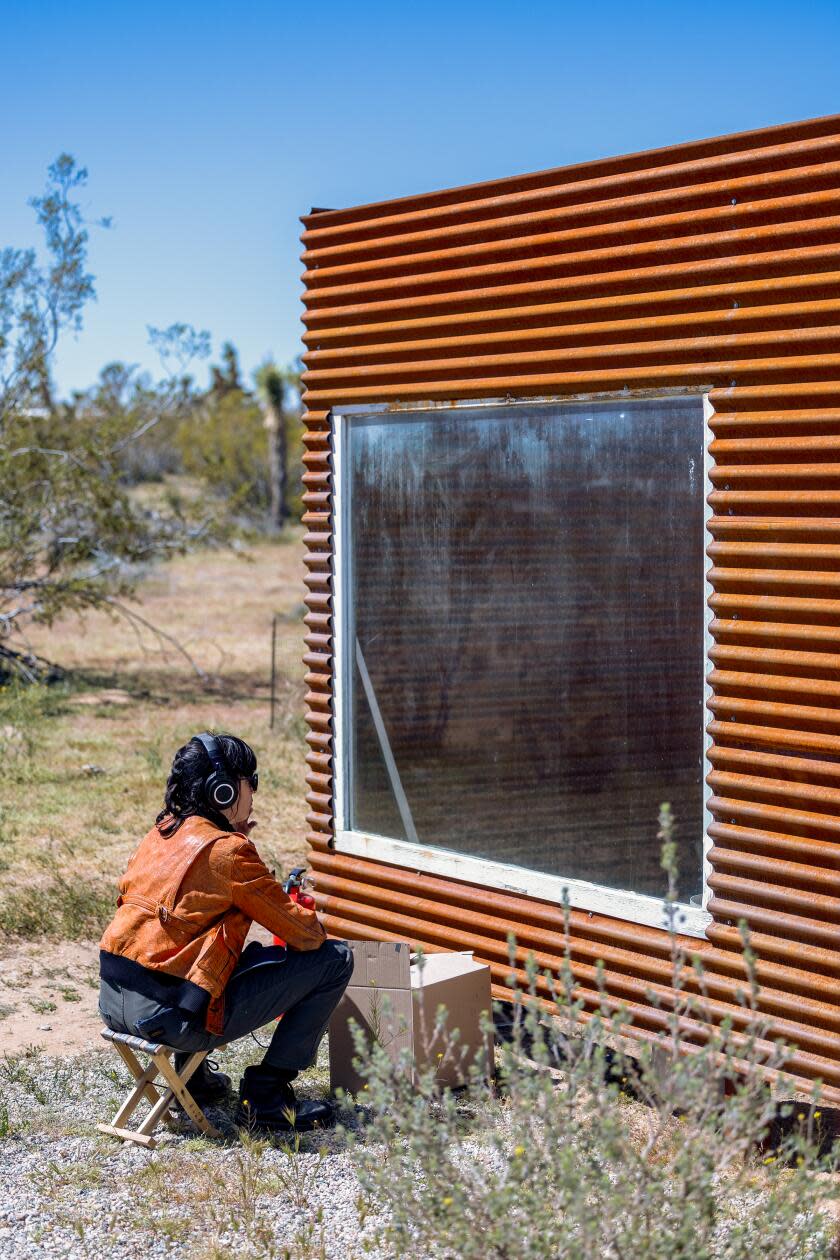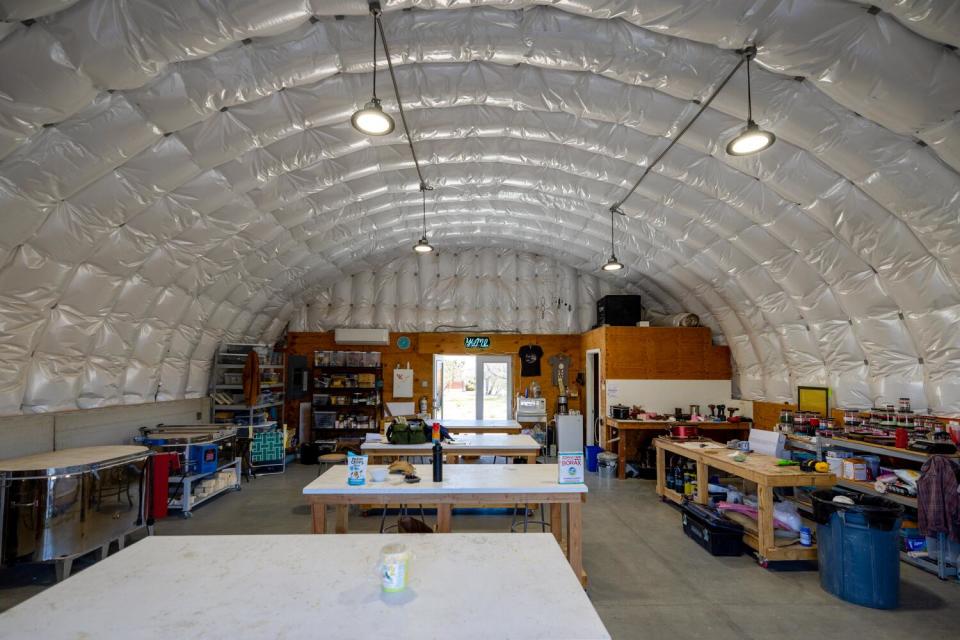Artists priced out of Los Angeles head to this creative hub in the high desert

At high noon on a Saturday, the last aluminum pour of the day is about to commence at the Yucca Valley Material Lab.
Heidi Schwegler, founder of the Lab, has crawled up to the roof to get the best vantage point for a video. Schwegler has a hard stance on safety while still allowing for wild experimentation — it's this attitude that makes the compound, with its art and recording studios, gallery, retrofitted campers and workshops like foundry and glass casting — a place of inspiration and community that pulls in people from all over the nation, but especially Angelenos looking for a reprieve from city life.


"This is the closest Derek and I could get to L.A. and afford it," said Schwegler, referring to her partner, Derek Monypeny, who works with musicians. "And I think if you ask a lot of artists out here, they'll say the same thing. It's as close as you can get and be a really decent place to live and have a huge studio and still be within driving distance of an art center."
It's this passion and energy that pull artists east. Every workshop sells out, attracting hot-shot artists and retired high school teachers alike. "It's really amazing to see my art and pedagogical practice come together outside of myself — in the form of a curved metal building plopped in the Mojave Desert," Schwegler said. "Never would I have imagined this when we bought this property in 2018."
Read more: What's happening in Joshua Tree is a 'dream' — and possibly a curse
The Lab has become a landing place for out-of-town artists and people looking for a way to plug into the desert scene. Many artists in Yucca Valley moved there on a whim after visiting for a weekend, much like Schwegler.
"I built this program because I was really afraid I would become a total recluse out here, because I didn't think anybody was out here," Schwegler said. "Come to find out, it's just like that saying: 'If you build it, they will come.'"
An artist and self-proclaimed materials junkie, Schwegler has pulled together funding from various sources, including AHA Projects, a nonprofit organization that supports creators, to cover residency and workshop costs, including airfare for teachers and housing for artists. Schwegler also often works with artists from the desert and Los Angeles for trade.
The Lab’s growing community has been cited as a reason why L.A. artists stay in the high desert — being able to see familiar faces at one or two cultural events a weekend is a balm after the smorgasbord and sprawl of the Southland.



In 2016, artists Ry Rocklen and Carolyn Pennypacker Riggs realized that a mortgage in the desert would be cheaper than a storage unit in Los Angeles. "I had a bunch of my 'Trophy Modern' furniture in storage and realized we could decorate our house with it and have a place to visit on the weekends," said Rocklen, of a series of sculptures he made for an exhibit.
After having a child in 2020 and spending more time in nearby Joshua Tree, they moved full-time and converted their garage into studio space. "It was such a strange time, with so many different things going on, adjusting was not really on my mind. It was kind of a blur between our new baby, the pandemic and the move," said Rocklen, who runs the gallery space Quality Coins in Yucca Valley. "The landscape, however, was our saving grace, as we were able to go on walks through the beautiful rocky hills."
Back at the metal workshop, the roaring sound of the kiln — which is used in the process of turning molten bronze and aluminum into objects — fills the quiet desert mesa with an ambient soundtrack.

Haydeé Jiménez, a recent artist in residence who splits her time between Los Angeles and Tijuana, crouched outside the metals workshop observation window wearing headphones and sunglasses, with her microphone wind-screened by a cardboard box. Amid the Joshua trees and creosote bushes, she recorded the sounds of the makeshift foundry.
Jiménez, who describes her art practice as revolving around "sound, music and vibrational sound healing," said she was excited to work with new materials.
“When I first got the invitation to join [the Lab] for a residency, I hoped to work with glass and create little resonant objects for the development of a sort of acoustic ASMR experience,” said Jiménez, referring to Autonomous Sensory Meridian Response, which is when one is soothed by sounds like whispers and taps. Later in the weekend, she’d layer the foundry recording over sounds made using bronze objects from the workshop in a performance with gong-master Tatsuya Nakatani at the Firehouse, a Joshua Tree venue.
Read more: Looking for L.A.'s art cool kids? They're hosting exhibits in laundry rooms and garages
Any given weekend at the compound can be action-packed; that Saturday, Lazy Eye Gallery opened Michelle Ross' "Before Pictures," a show of sculptural paintings inside the nave of a water tower converted into a small funnel of a gallery space with a ladder to the roof that affords a view of the mesa.
But as the artists’ community grows, so has interest in real estate in Yucca Valley, Joshua Tree and Twentynine Palms, once considered more affordable areas. Housing prices in Yucca Valley have grown 80% since 2019, according to Zillow, although the steep pandemic rush has since cooled.

"The presence of Airbnbs is corrosive," said Riggs, observing that interested buyers have grown beyond "Silver Lake hipsters with a getaway cabin." Last year, Yucca Valley capped short-term rentals at 10% of its housing stock. According to Redfin, most people searching to buy Yucca Valley homes today are in San Francisco.
Between the expansive landscape, cheaper-than-L.A. studio space and the small-town feel, the desert offers the experience of slow time — which can help some artists tap into a flow state without the day-to-day distraction of city living. But all that free time and space can be intimidating.
Ceramic artist and designer Mansi Shah left Los Angeles in 2020 after another artist friend told her about a house for rent in Yucca Valley; she packed up and headed to the desert within a few weeks. "There was 500 feet of open desert between me and my nearest neighbor. I remember those first few months, I was terrified of everything. The wind, the quiet, the desert critters," said Shah.


“My introduction to life in America was the desert,” said Shah. She grew up in Palm Springs with her hotel manager father after her family emigrated from India. But later, she'd lived in Los Angeles, then New York and then returned to Los Angeles. “Now moving back here to the high desert, setting up my home and studio, it feels I've come back full circle.”
When she moved to L.A. in 2017, she realized that it had radically changed — most noticeably, the rent prices.
"But every exploding colorful sunset, every jackrabbit, every coyote sighting changed my brain chemistry," said Shah. "I began to soften and ease into the different pace of life here. There's a reverence for nature here that I hadn't experienced before."
In the summer months, the average temperature is 95 degrees Fahrenheit. “My studio schedule revolves around outside temperatures,” said Shah. “I tend to work early mornings and nights in the summer and run the kiln overnight.”
Read more: 11 places in L.A. to get your creativity flowing. Pottery! Neon bending! Bookbinding!
Workshops at the Lab are about to wind down for the summer, making the last bronze pour of the day bittersweet.
After pouring hot aluminum into one of her stick-shaped molds and letting it cool in a pile of dirt, a participant took a ball-peen hammer and cracked open the rough silicate mold, like a geode.

The next day, participants buffed their objects and applied chemical solvents to create patinas and finishes before heading back to the city. After the last pour finished, the crucible was set aside to cool.
"That's a wrap," said Schwegler, while everyone clapped.
Sign up for our L.A. Times Plants newsletter
At the start of each month, get a roundup of upcoming plant-related activities and events in Southern California, along with links to tips and articles you may have missed.
Sign me up.
This story originally appeared in Los Angeles Times.


